- Submissions

Full Text
COJ Electronics & Communications
Two Purpose-Oriented RIS-Aided Schemes to Enhance and Evaluate the Performance of Wireless Communication
Ali H Wheeb1*, Fahimuddin Shaik2 and Shaik Karimullah2
1Department of Aeronautical Engineering, College of Engineering, University of Baghdad, Iraq
2Annamacharya Institute of Technology and Sciences, India
*Corresponding author:Ali H Wheeb, Department of Aeronautical Engineering, College of Engineering, University of Baghdad, Iraq
Submission: October 10, 2024;Published: October 18, 2024

ISSN 2640-9739Volume3 Issue1
Abstract
Intelligent Reflecting Surface-IRS or Reconfigurable intelligent surface-RIS is a transmission technology that can enhance the performance of wireless communication systems by reflecting electromagnetic signals in a specific direction. The question is which RIS-aided scheme is the most appropriate for a given wireless communication scenario, considering performance factors such as energy efficiency and transmit power. In the literature, two oriented RIS-aided schemes are usually determined: The Exhaustive RIS-Aided (ERA) scheme and the Opportunistic RIS-Aided (ORA) scheme. Both schemes have been considered for evaluating the performance of wireless communication. This paper presents a methodology and analysis of RIS technology for wireless communication systems. It presents a mathematical model to optimize the reflected signal’s phase shift and evaluates the system’s performance using numerical simulations. Moreover, it proposes two algorithms for implementing the ERA and ORA schemes. It analyzes the ERA and ORA methods transmit power schemes to determine their energy efficiency. The analysis of the experimental investigations shows that the ORA scheme has sophisticated transmit power values and attains maximum energy efficiency by using less energy compared to the ERA scheme. ORA is superior to ERA in terms of energy and efficiency.
Keywords: Reconfigurable intelligent surface (RIS); RIS-aided schemes; Performance evaluation; Wireless communication; Transmit power; Energy efficiency
Abbreviations: AI: Artificial Intelligence; AP: Access Point; BS: Base Station, CS: Compressive Sensing (theory); CSI: Channel State Information; ERA: Exhaustive RIS-Aided (scheme); IoT: Internet of Things; IRS: Intelligent Reflecting Surface; MISO: Multiple-Input and Single-Output; MMSE: Minimum Mean Square Error (estimation); ORA: Opportunistic RIS-Aided (scheme); QoS: Quality of Service; RIS: Reconfigurable Intelligent Surface; RL: Reinforcement Learning; SNR: Signal-to-Noise Ratio, UAV: Unmanned Aerial Vehicle; 5G: 5th Generation; 6G: 6th Generation
Introduction to DigiCon
To deliver ubiquitous wireless services, high Quality of Service (QoS) and on-demand content for millions of connected devices, sixth-generation (6G) wireless communication systems [1] need to have large bandwidth, low latency and AI integration. To support these services, new transmission technologies are needed. One of these technologies is the Reconfigurable Intelligent Surfaces (RISs) that improve the performance of such communication systems [2]. A RIS is a collection of reflecting elements used to reconfigure incident Electromagnetic (EM) signals [3]. Α RIS is considered as a plain exterior made up of a huge amount of small, passive reflecting elements, such as printed antennas or metamaterials, that can be electronically reconfigured to reflect and control the transmission of EM signals (Figure 1). In wireless communication systems, RISs can alleviate many problems such as low-quality signals and wide coverage areas because RISs can proactively change the wireless communication environment [2]. RIS technology can optimize the reflected signal to enhance the signal quality, increase signal coverage, and increase the energy efficacy of a wireless communication system [4]. RISs can be used to increase the performance of wireless communication by improving signal strength, reducing interference, and increasing capacity [5]. By perceptively manipulating the phase, polarization and magnitude of the reflected signals, a RIS can create multiple paths for a signal to travel between a transmitter and a receiver, leading to a significant improvement in signal quality and overall system performance [6]. One of the key ad-vantages of RISs is their low power consumption since they do not require active electronic components or their own power source. This makes them ideal for use in energy-constrained environments, such as the Internet of Things (IoT) applications [7].
Figure 1:The context of a RIS.
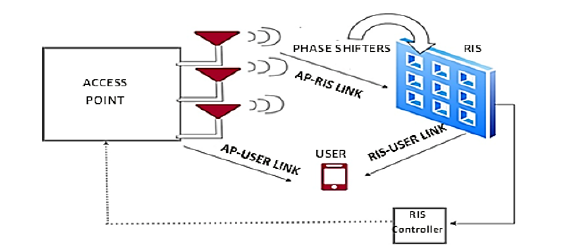
To abridge, the main benefits of RIS technology are the
following:
A. Increased Signal Quality: By optimizing the reflected
signal, a RIS can significantly improve signal quality, reduce
interference, and increase the Signal-to-Noise Ratio (SNR) of
wireless communication systems.
B. Extended Coverage: By reflecting the signal in different
directions, a RIS can extend the coverage area of a wireless
communication system, especially in indoor environments
where the signal may be blocked by walls or other obstacles.
C. Energy Efficiency: By optimizing the reflected signal, a RIS can
reduce the energy consumption of a wireless communication
system, which is especially important for battery-powered
devices.
D. Low Cost: RIS technology is based on passive elements and is
low-cost.
The above benefits have been comprehensively studied in the
literature. In [8], the researchers analyzed the potential benefits
of RIS technology in 5G and beyond networks. They established
that the RIS technology can increase the system capacity, extend
coverage, reduce interference, and increase the energy efficacy
of wireless communication systems. Similarly, the authors [9]
presented a comprehensive analysis of RIS technology’s benefits,
including its potential applications in smart cities, IoT, and vehicular
communication systems. The RIS technology has some limitations,
including:
A. Complexity: The design and optimization of RIS systems
can be complex, especially in large-scale deployments. In [10],
the authors presented a review of the recent advancements for
obtaining the balance of a RIS system. They also highlighted the
challenges of optimizing large-scale RIS systems, including the
complexity of the optimization problem and the need for efficient
algorithms that implement RIS-aided communication schemes.
B. Sensitivity to Blockage: RIS systems are sensitive to
blockage and obstructions, which can reduce the effectiveness of
the reflected signal. In [11], the researchers considered the outcome
of blockage on the operation of RIS-assisted communication
networks. They demonstrated that the presence of obstacles can
suggestively reduce the effectiveness of the reflected signal and
affect the system’s performance.
Figure 2 depicts the internal structure of a RIS. It provides insights into the various layers and components of the RIS structure. The Inner layer refers to the RIS’s core component. It is made up of an array of intelligent reflecting elements that manipulate the reflected electromagnetic signals. The Middle layer is a transitional layer between the Inner and Outer layers. It serves as a foundation for the intelligent reflecting elements in the inner layer. The RIS’s Outer layer is its protective and structural layer. It encapsulates the inner layer and provides the RIS structure with physical stability and protection. The outer layer is typically composed of materials that ensure durability, mechanical strength, and resistance to environmental factors. The Substrate is the layer at the bottom of the RIS structure that comes into contact with the propagation medium or the surface where the RIS is deployed. It serves as the RIS assembly’s foundation and provides mechanical support. Furthermore, the Substrate may influence RIS performance by interacting with electromagnetic waves and influencing their propagation characteristics. The internal structure of a RIS is fabricated with a huge number of tiny and individually controllable reflective elements. These elements are typically made up of a metallic surface with electronic circuits that enable the regulation of the reflection characteristics of every element. The reflective elements on the RIS are usually arranged in a regular pattern or grid, which can be optimized for different applications. The spacing and size of the elements determine the resolution of the RIS, with smaller and denser arrays providing higher resolution and more precise control of the reflected signals. The electronic circuits embedded in each reflective element allow for independent control of the amplitude of the reflected signal. This enables the RIS to dynamically adjust the reflection properties of each element to optimize the signal strength and reduce interference. The control signals for each element are typically generated by a central controller or signal processing unit, which analyses the wireless communication channel and determines the optimal reflection properties of RIS for a given scenario. In addition to the reflective elements, a RIS may also include sensing and communication parts to enable interaction with the wireless communication system.
Figure 2:The internal structure of a RIS.
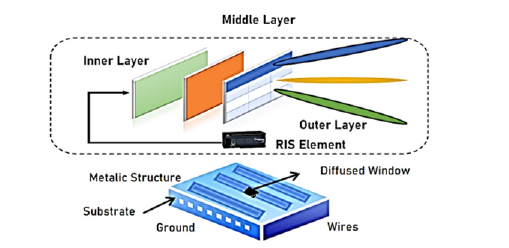
This can include: (1) sensors for measuring channel
characteristics, and (2) feedback mechanisms for adjusting the
reflection properties in real-time. Overall, the internal structure
of a RIS is designed to provide precise and dynamic control of
the reflected signal properties. By utilizing a great number of
individually controllable reflective elements, a RIS can optimize
the wireless communication channel and enhance the efficiency
and performance of a wire-less communication system. Due to
their affordability, RISs may be installed on a variety of surfaces,
as well as (but not restricted) building frontages, aerial platforms,
interior walls, highway polls, roadside billboards, car windows,
and people’s clothing. RISs have the potential to be adopted in a
wide range of wireless communication scenarios including indoor
and outdoor environments, cellular networks, and wireless sensor
networks. They are also being considered for use in future 5G and
6G networks, where they could play a key role in improving network
performance and coverage [12]. The main implementations of RISs
in various wireless communication topologies are:
a) RIS-enhanced cellular networks further than 5G;
b) Indoor communications assisted by RIS;
c) Unmanned systems assisted by RIS for smart cities; and
d) RISs in intelligent IoT networks.
In [13], the authors presented a comprehensive survey of RIS technology’s applications in various communication systems including cellular networks, wireless sensor networks and satellite communications. They demonstrated that RIS technology can improve the system performance in various scenarios, such as indoor environments, urban areas, and rural areas, as shown in Figure 3.
Figure 3:The basic operation of RIS technology.
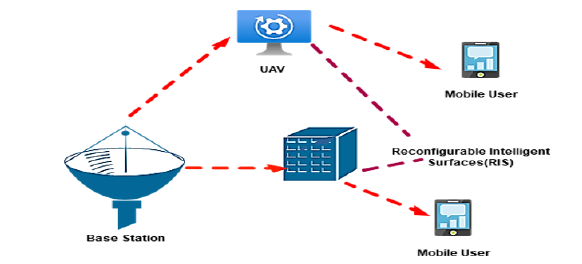
Exhaustive RIS-Assisted (ERA) and Opportunistic RISAssisted (ORA) schemes
There are two primary schemes for implementing RISassisted communication: (1) Exhaustive RIS-Assisted (ERA) and (2) Opportunistic RIS-Assisted (ORA). Using an exhaustive search algorithm, an ERA scheme optimizes the RIS reflection coefficients to maximize the conventional signal power at the destination. In this method, the RIS is considered a passive component, and the problem with optimization is expressed as a non-convex optimization problem. While this method can achieve optimal performance, it is not appropriate for real-time applications due to its high computational complexity [14]. On the other hand, the ORA scheme is a more realistic approach that involves adjusting the RIS reflection coefficients opportunistically dependent on the Channel State Information (CSI). This method exploits the time-varying nature of the wireless channel and adaptively modifies the RIS to enhance the excellence of the received signal. The ORA method is more efficient than the ERA scheme. However, its performance may not be optimal in all instances [14].
The following are the primary contributions of this paper:
a) Using Ref [15], we present a methodology for considering RISassisted
wireless communication systems.
b) We show a mathematical model for optimizing the energy
and efficiency of reflected signals in RIS-assisted wireless
communication systems.
c) We suggest two RIS-aided, goal-oriented methods and
evaluate their performance. We assess the effectiveness of the
RIS-aided wireless communication system using simulations
that focus on transmit power. We show that the suggested ORA
scheme works better than the alternative ERA scheme in terms
of energy and efficiency.
The rest parts of this research work are organized as follows. Related work is included in Section 2. Section 3 outlines the suggested algorithms for implementing the RIS-aided schemes. It also describes the RIS system’s model used including its parameters. Section 4 presents the simulation experiment conducted. It presents and analyzes the experimental results of the projected RIS-assisted wireless communication system. Section 5 concludes the paper and discusses future research directions for implementing RIS-aided schemes.
Related Work
In [16], the researchers proposed an innovative scheme for RISassisted communication systems based on Compressive Sensing (CS) theory. This scheme aims to optimize the shift in phase of the RIS elements to enhance the signal quality, reduce interference, and improve the system’s capacity. In [17], a novel framework for RIS-assisted systems of communication is used that is based on Artificial Intelligence (AI) techniques. Their scheme [17] aims to optimize the RIS elements’ phase shift using AI algorithms, such as Reinforcement Learning (RL), to enhance the system performance. For both multi-user and single-user scenarios, Wu et al. [18] suggested a Multiple-Input and Single-Output (MISO) RISupgraded system that requires less transmit power. To find locally optimal solutions, Alternating Optimization (AO)-based algorithms were developed. When designing the passive beamforming using the Semi-Definite Relaxation (SDR) method, it was discovered that in a multi-user environment, a RIS may simultaneously increase the required signal strength and reduce interference. Discrete RIS phase shifts were taken into deliberation in [19] to further study the same issue. In addition, effective successive refinement techniques were developed to decrease the computational complexity. It was demonstrated that the suggested low-complication algorithms are able for producing results that are close to ideal.
In a network with RIS support, Han et al. [20] looked at the Physical-layer broadcasting to minimize the amount of Transmit power needed to meet all users’ QoS needs. The transmit power of the ERA scheme needs to be enhanced by 1.8 dBm in accordance with the statistical characterization and modeling research [21] of distributed multi-RIS-supported wireless network systems. The resilient beamforming proposal for a RIS-enhanced multi-user MISO system along with faulty CSI expectations was examined in [22]. All users’ QoS needs were met while minimizing the transmit power in all channel fault realizations. Li et al. [23] considered a MISO Non-Orthogonal Multiple Access (NOMA) downlink network of communications to reduce overall transmit power by simultaneously producing the Transmit precoding vectors and the reflecting coefficient vector. A dependable RIS power consumption architecture was described in terms of the number of reflection components and phase resolutions at the RIS. Ref [24] proposed a novel strategy for maximizing energy efficiency in a RIS-enhanced multi-user MISO system. According to Yuan et al. [25], RISs have the potential to boost wireless networks’ spectrum and energy efficiency by intelligently altering the environment in which electromagnetic signals propagate.
The Proposed Algorithms
Two determinations concerned with multi-RIS-aided methods have been considered for assessing the performance of wireless communication. In both schemes (ERA and ORA), the optimal phase shift for each RIS element refers to the phase shift value that results in maximum signal power or energy efficiency at the destination. An exhaustive search technique is utilized in the ERA scheme to discover the ideal phase shift values for each RIS element in order to improvise the conventional power of the signal. On the other hand, the ORA system opportunistically modifies the phase shift values of the RIS elements depending on the Channel State Information (CSI) to improve the received signal quality.
The RIS system model adopted
Designing an IRS system involves optimizing the reflection
properties of each element to achieve the desired performance
metrics. This typically requires the use of various mathematical
equations and models, including:
Reflection coefficient: The reflection coefficient (Γ) of each
element can be calculated using Eq. (1):

Where Z is the impedance of the reflective element, and Z0 is the
impedance of the surrounding channel (usually air). The reflection
coefficient governs the amplitude of the returned signal and can be
adjusted by controlling the impedance of the reflective element.
Path Loss: The Path Loss (PL) of the wireless communication
channel can be calculated using Eq. (2):

Where d is the space between the receiver and Transmitter, d0
is the reference distance (usually 1 meter), and α is the path loss
exponent. The path loss determines the attenuation of the signal
as it travels through the wireless communication channel and can
be used to optimize the positioning and orientation of the RIS to
maximize the reflected signal strength.
Channel capacity: The channel capacity (C) of the wireless
communication channel can be calculated using Eq. (3):

Where B is the channel bandwidth and SNR is the signal-tonoise
ratio. The greatest quantity of data that may be transmitted
via a wireless communication channel is determined by channel
capacity and can be used to optimize the reflection properties of
the RIS to maximize the channel capacity.
Signal-to-Noise Ratio (SNR): The SNR of the wireless
communication channel can be calculated using Eq. (4):

Where Psignal is the power of the transmitted signal, and Pnoise is the power of the noise in the channel. The SNR determines the value of the received signal and can be used to optimize the reflection properties of the RIS to maximize the SNR. In the design of our RIS system, we used Eqs. (1)-(4) to optimize the reflection properties of each element and achieve the desired performance metrics for the wireless communication system. By changing the reflection coefficient, taking path loss into account, maximizing channel capacity, and increasing SNR, the RIS can be tweaked to get the desired performance metrics.
Assumptions
During the execution of the proposed ERA and OR Algorithms,
we assume the following:
a. The wireless communication system operates in a Line-of-
Sight (LOS) environment, where there are no substantial
obstacles that could cause signal attenuation or reflection.
However, we hope to calculate the robustness and working of
the wireless communication system under more realistic and
challenging scenarios by incorporating NLOS conditions into
the algorithms.
b. The closely spaced and dense RIS elements allow for precise
control of the phase shift of the redirected signal.
c. The uniform size and shape of the RIS elements simplify the
modeling and design of the RIS system.
d. It is assumed that both the transmitter and receiver antennas
are omnidirectional and have a uniform radiation pattern.
e. The wireless communication system operates in a narrowband
regime, allowing for the application of straightforward signal
processing algorithms.
f. The Channel State Information (CSI) is expected to be exactly
known, enabling accurate signal propagation prediction and
manipulation.
The proposed algorithm for the ERA scheme
Hereafter, we present our algorithm for an exhaustive RISaided scheme in wireless communications with the necessary mathematical equations:
Table 1:
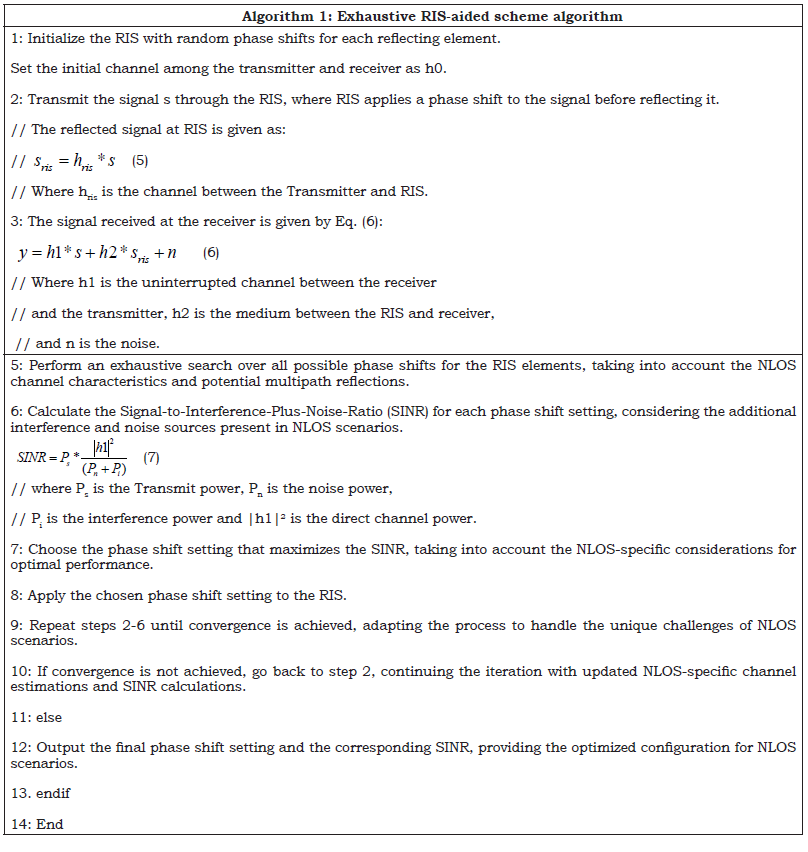
It is noteworthy that in step/line 5, the number of potential phase shift settings is exponential in the number of reflecting elements. Therefore, an exhaustive search may not be feasible for large RISs. In such cases, we use optimization algorithms such as gradient descent or genetic algorithms.
The algorithm for the ORA scheme
Hereafter, we present our stepwise algorithm for an ORA scheme in wireless communications with the necessary mathematical equations:
Table 2:
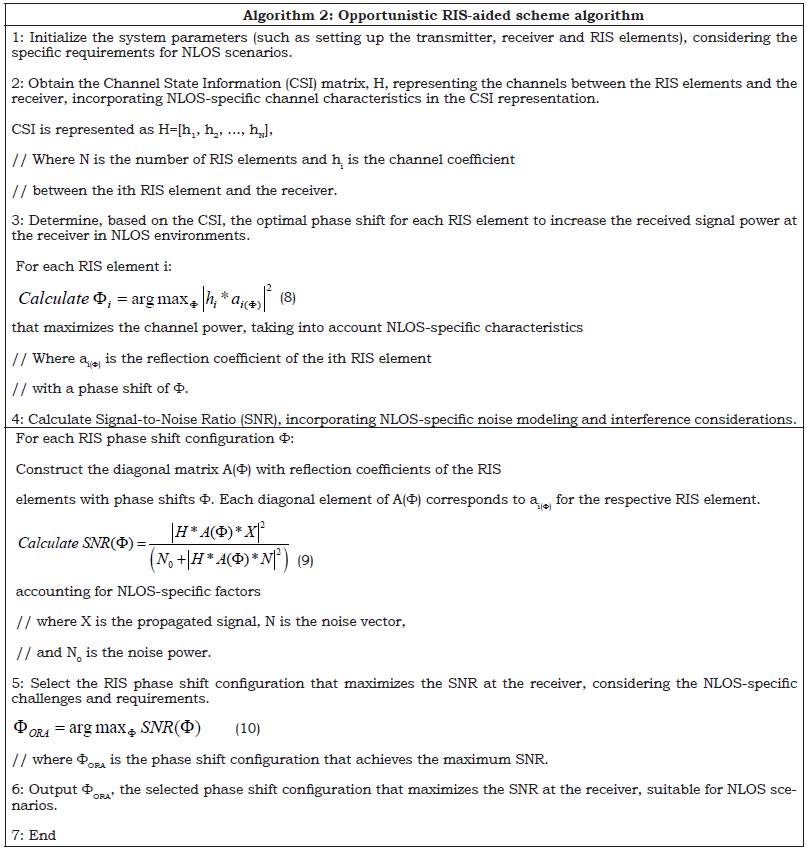
The specific steps involved in step/line 2 for obtaining the CSI
as of the transmitter towards the receiver through the RIS elements
are the following:
A. Training phase: During the training phase, the
transmitter transmits known pilot signals to the receiver via the RIS
elements. These pilot signals are designed with specific properties
that allow the receiver to accurately estimate the channel response.
The pilot signals are sent through the RIS elements, and the received
versions at the receiver are used for further analysis.
B. Channel estimation: The receiver collects the received
pilot signals and uses signal processing techniques to ap-proximate
the channel coefficients. To infer channel characteristics, these
techniques typically involve comparing known transmitted pilot
signals with received signals. The effects of the RIS elements on the
channel response are considered during the estimation process.
C. RIS feedback: Once the channel coefficients have been
estimated, the receiver can provide feedback to the transmitter,
including information about the channel state. The estimated
channel coefficients hi for each RIS element can be included in this
feedback. This feedback can be used by the transmitter to adjust its
transmission strategy and improve communication performance.
Now, we present the three types of overhead-reduced channel
estimation solutions [26]. These solutions/methods pro-vide
insight into the attainment of CSI.
a) Two-Timescale-Based Channel Estimation: In RIS-assisted
communication systems, the two-timescale channel property may
be employed to reduce pilot overhead for channel estimate. Because
of the fixed placements of the BS and RIS, the channel that connects
them (G) remains largely stable for an extended period of time,
leading to a big-time frame feature. The tiny timescale property
refers to the fact that, due to the user’s mobility, the channels
connecting the user with the RIS (hr) with the user to the BS (hd)
alter on a considerably smaller timescale. Using this property, it is
possible to create channel estimation schemes that take advantage
of timescale differences and reduce pilot overhead accordingly.
b) Multi-User Correlation-Based Channel Estimation:
Another method for reducing pilot overhead is to estimate the
cascaded channels directly using multi-user correlation. Because
they communicate with the BS via the same RIS in a multi-user
RIS-assisted communication system, the channels associated with
different users share correlations, resulting in a reduction in pilot
overhead when compared to traditional methods.
c) Sparsity-Based Channel Estimation: This method uses the
sparsity property of angular domain channels to achieve overheadreduced
channel estimation. Because of the limited number
of propagation paths in conventional wireless communication
systems, in the angular domain, the channel reaction between the
user’s device and the BS (hd) is sparse.
Simulation Experiment
In this section, we present a simulation of the proposed algorithms and compare their performance. Experimental verification was conducted on the MATLAB (2022b) simulation platform on a computer system with configurations of Intel Core i5 with 1.80GHz Processor, 8.00GB RAM, and 64-bit Windows operating system. The toolboxes used in MATLAB were Communication System Toolbox, Antenna Toolbox, DSP system toolbox, and Signal Processing Toolbox. The simple schematic representation of our experimental work is provided in Figure 4. The experiment examines the influence of Reconfigurable Intelligent Surfaces (RIS) on wireless communication. The process commences with the establishment of fundamental simulation elements, including the number of trials, RIS components and node placements. The simulation loop serves as the core stage of activity. In this phase, the direct signal between the source and destination is computed, alongside the simulation of signal reflections from RIS components to comprehend their implications. After simulation, ERA and ORA rates are computed to evaluate the system’s efficiency. For clarity, Signal-to-Noise Ratios (SNRs) are converted. In the numerical results phase, ERA and ORA are employed to determine power requirements and rate ranges. Following this, power consumption is quantified and energy efficiency is assessed. The conclusions are visually depicted, with plots showcasing the relationship between power and achieved rates, as well as the energy efficiency trend at various rates. The schematic outlines the journey from initial setup to insights, providing valuable guidance for improved wireless communication design. The simulation parameters set in the experiment are (1) the number of RISs to be used; (2) the Amplitude reflection coefficient and (3) the Scale parameter with a Heuristic setting. Table 1 summarizes the simulation settings (parameters) for both algorithms (schemes). The parameter values have been maintained constant for both schemes so that performance evaluations may be evaluated on equal footing.
Figure 4:Schematic representation of the experiment carried out.
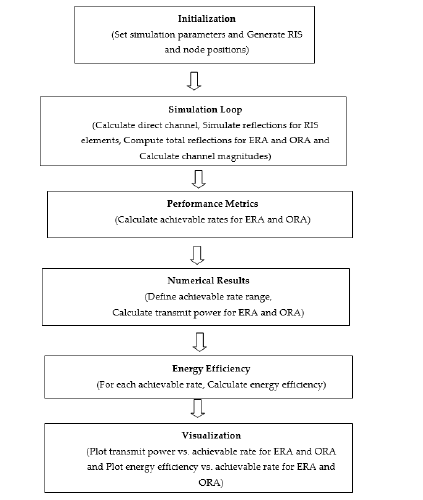
Table 3:Simulation parameters were used for both schemes (ORA and ERA).

Analysis of simulation results
Simulation results of RISs are a way to evaluate the performance of these surfaces in wireless communication systems. RIS is a new technology that uses a huge number of passive reflecting components to improve wireless communication links’ performance. To achieve specific signal manipulation goals such as beamforming, interference cancellation, and signal enhancement, the RIS must dynamically adjust the phases and amplitudes of its reflecting elements. This adaptation process necessitates external control and electronic manipulation, as well as the use of an active energy source. While RIS is passive in terms of the radio signals with which it interacts, its dynamic configuration and adaptation in-volve active actions and an external energy source, making it not entirely passive. The simulation results describe how the RIS elements can enhance the signal strength and coverage area by reflecting the incoming signal in a desired direction. First, the static model (Figure 5) generates random positions for nodes (source, destination, RIS elements) within the specified network area to establish the initial spatial configuration of the wireless network.
Figure 5:Generation of random positions for node (source, destination, RIS elements).
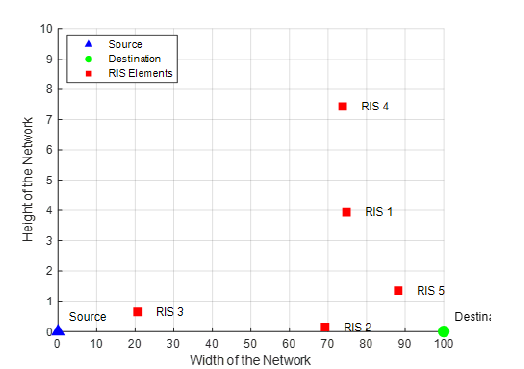
Table 4:Transmit power of the ORA scheme.

Table 5:Transmit power of the ERA scheme.

Figure 6:Transmit power of ERA and ORA schemes at RIS values 2, 3, 4 and 5.
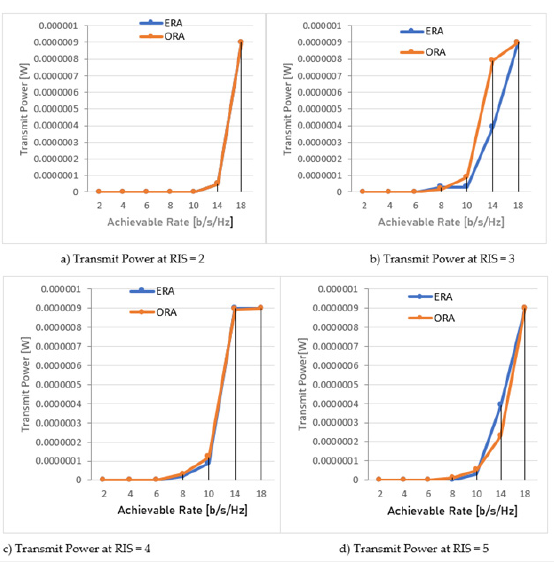
The simulation results of RIS also analyze how different
factors, such as the number of reflecting components, the angle of
incidence, and the position of the RIS, impact the communication
link’s quality. For instance, the simulation may show that the RIS’s
performance improves as the number of reflecting components
increases or as the RIS is placed closer to the receiver. Moreover,
the simulation results can be used to compare the performance
of RIS with other technologies, such as traditional repeaters or
amplifiers. The comparison can reveal the advantages of RIS in
terms of cost-effectiveness, power efficiency, and coverage area.
Overall, the simulation results of RIS for Transmit Power provide
valuable insights into the potential of this emerging technology for
improving wireless communication systems’ performance as shown
in Figure 6. Upon observing the graphs above, we can analyze the
variations of the ERA and ORA Transmit power schemes as shown
in Table 2 & 3. Significant changes in the ERA and ORA Transmit
power schemes can be detected after analyzing the graphs in Figure
6(a & b) and referring to the data in Table 2&3. In particular, we can
see the following tendencies:
a) Both ERA and ORA schemes have the same transmit
power when RIS=2.
b) At RIS=3, the ORA scheme grows at a slower pace than the
ERA scheme until it reaches an average achievable rate of 10 b/s/
Hz. However, at 14 b/s/Hz, ORA’s Transmit Power exceeds ERA’s
and they are equal at 18 b/s/Hz.
c) In terms of Transmit Power, the ORA scheme outperforms
ERA for all average achievable rates when RIS=4.
d) At RIS=5, ERA outperforms in terms of Transmit Power
up to an average achievable rate of 10 b/s/Hz. On the other hand,
ORA surpasses ERA at 14 b/s/Hz and becomes equal at 18 b/s/Hz.
Overall, the ORA scheme beats the ERA system in terms of Transmit Power over the majority of RIS values. It is note-worthy that an increase in Transmit power levels is observed when different RIS values are used. Higher transmit power numbers allow signals to go further and more efficiently penetrate obstacles. Figure 7 shows the variations in the projected methods for energy efficiency. The observation of the above graphs helps in analyzing these variations. The ORA scheme has higher values when compared to the ERA scheme, and it also attains maximum energy efficiency by using less energy to perform the ERA and ORA schemes. Therefore, the ORA method is extra efficient than the ERA arrangement. Additionally, the paragraph highlights the analysis of the ERA scheme’s efficiency by using different RIS values, which reveals that the ERA scheme has less efficiency as shown in Table 4 & 5. The Exhaustive RIS-assisted scheme improves performance by examining all phase shift settings for RIS elements. It finds the best configuration to improve signal quality, coverage and capacity while increasing SINR. The scheme is adaptable to changing environments by evaluating multiple phase shift configurations for varying channel conditions and interference sources. It strives for precision and accuracy by thoroughly investigating all possible settings and im-proving performance metrics.
Figure 7:The energy efficiency of the ORA and ERA schemes at RIS values 2, 3, 4 and 5.
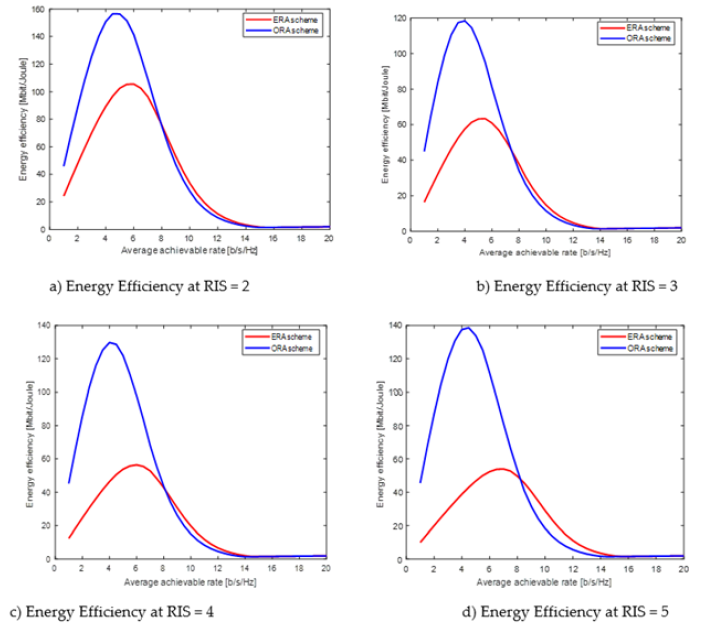
Table 6:The energy efficiency of the ORA scheme.

Table 7:The energy efficiency of the ERA scheme.

It improves coverage and range by adjusting RIS phase shifts to effectively reflect and re-direct signals, benefiting rural connectivity and large-scale IoT deployments. The scheme employs RIS technology to address coverage, capacity, and interference issues in next-generation wireless networks such as 5G. Because of its adaptability and performance optimization, it can be used indoors and outdoors in a variety of settings, including office buildings, stadiums, and rural areas. The Opportunistic RIS-Aided (ORA) scheme optimizes system performance by adjusting the phase shifts of RIS elements based on real-time conditions. It is adaptable and scalable and it integrates seamlessly into existing networks with minimal changes. The scheme promotes energy efficiency by selectively activating RIS elements, saving energy, and extending battery life. It also improves communication reliability by adjusting RIS phase shifts to compensate for fading and increase signal strength. The ORA scheme is useful in IoT networks because it improves communication efficiency in a variety of applications. We purposely utilized a static node placement model to study how RIS elements affect communication performance under controlled conditions. We investigated how RISs affect interference patterns, energy efficiency, and other static aspects. Our future research will include mobility-related topics and will be used to develop Unmanned Aerial Vehicles (UAVs) [27-29].
Conclusion
Reconfigurable Intelligent Surface (RIS) or Intelligent Reflecting Surface (IRS) technology has the potential to improve the performance of wireless communication systems using directed electromagnetic wave reflection. This article provided a thorough analysis of two projected schemes and evaluated their performance in wireless communication. In terms of energy and efficiency, the analysis revealed that ORA outperforms ERA. Furthermore, the article discussed the advantages, disadvantages, and applications of RIS technology and presented a mathematical model to optimize the Transmit Power of the reflected signal. The numerical simulations have demonstrated the efficiency of RIS technology in enhancing the performance of wireless communication systems. RIS technology has the potential to transform many industries in the future, including telecommunications, IoT, and autonomous systems. Advanced RIS-based architectures and algorithms could lead to even more efficient and energy efficient communication systems. Furthermore, RIS technology could be combined with other emerging technologies like Machine Learning (ML), Artificial Intelligence (AI) and 5G networks to achieve even better results. However, additional research and testing are needed to fully realize the potential of RIS technology and its integration with other technologies.
References
- Akhtar MW, Hassan SA, Ghaffar R, Jung H, Garg S, et al. (2020) The shift to 6G communications: Vision and requirements. Hum Cent Comput Inf Sci 10: 53.
- Basar E, Di Renzo M, De Rosny J, Debbah M, Alouini MS, et al. (2019) Wireless communications through reconfigurable intelligent surfaces. IEEE Access 7: 116753-116773.
- Liu Y, Liu X, Mu X, Hou T, Xu J, et al. (2021) Reconfigurable intelligent surfaces: Principles and opportunities. IEEE Communications Surveys & Tutorials 23(3): 1546-1577.
- Rappaport TS, Sun S, Mayzus R, Zhao H, Azar Y, et al. (2013) Millimeter wave mobile communications for 5G cellular: It will work! IEEE Access 1: 335-349.
- Karimullah S, Vishnuvardhan D, Bhaskar V (2022) An improved harmony search approach for block placement for VLSI design automation. Wireless Pers Commun 127: 3041-3059.
- Hu S, Rusek F, Edfors O (2017) The potential of using large antenna arrays on intelligent surfaces. IEEE 85th Vehicular Technology Conference (VTC Spring), Sydney, Australia, pp. 1-6.
- Rusek F, Persson D, Lau BK, Larsson EG, Marzetta TL, et al. (2012) Scaling up MIMO: Opportunities and challenges with very large arrays. IEEE Signal Processing Mag 30(1): 40-60.
- Sainath B, Mehta NB (2012) Generalizing the amplify-and-forward relay gain model: An optimal SEP perspective. IEEE Trans Wireless Commun 11(11): 4118-4127.
- Karimullah S, Basha SJ, Guruvyshnavi P, Sathish Kumar RK, Navyatha B (2021) A genetic algorithm with fixed open approach for placements and routings. In: Kumar A, Mozar S (Eds.), ICCCE 2020, Springer, Singapore 698: 599-610.
- Karimullah S, Vishnuvardhan D (2019) Experimental analysis of optimization techniques for placement and routing in ASIC design. In: Kumar A, Paprzycki M, Gunjan V (Eds.), ICDSMLA 2019, Springer, Singapore, pp. 908-917.
- Heath RW, Sandhu S, Paulraj A (2001) Antenna selection for spatial multiplexing systems with linear receivers. IEEE Communications Letters 5(4): 142-144.
- Karimullah S, Vishnuvardhan D (2021) Simulation of optimized architecture for the estimation of congestion during placement and routing. Design Engineering, pp. 755-764.
- Karimullah S, Vishnu Vardhan D, Basha SJ (2019) Floor planning for placement of modules in VLSI physical design using harmony search technique. In: Kumar A, Paprzycki M, Gunjan V (Eds.), ICDSMLA 2019, Springer, Singapore, pp. 1929-1936.
- Trigui I, Ajib W, Zhu WP, Di Renzo M (2022) Performance evaluation and diversity analysis of RIS-assisted communications over generalized fading channels in the presence of phase noise. IEEE Open Journal of the Communications Society 3: 593-607.
- Karimullah S, Vishnuvardhan D (2023) Pin density technique for congestion estimation and reduction of optimized design during placement and routing. Applied Nanoscience 13: 1819-1828.
- Hum SV, Perruisseau-Carrier J (2013) Reconfigurable reflect arrays and array lenses for dynamic antenna beam control: A review. IEEE Trans on Antennas and Propagation 62(1): 183-198.
- Karimullah S, Vishnuvardhan D (2019) Iterative analysis of optimization algorithms for placement and routing in asic design. In: Kumar A, Paprzycki M, Gunjan V (Eds.), ICDSMLA 2019, Springer, Singapore, pp. 1947-1958.
- Wu Q, Zhang R (2019) Intelligent reflecting surface enhanced wireless network via joint active and passive beamforming. IEEE Trans Wireless Commun 18(11): 5394-5409.
- Wu Q, Zhang R (2019) Beamforming optimization for wireless network aided by intelligent reflecting surface with discrete phase shifts. IEEE Trans Commun 68(3): 1838-1851.
- Han H, Zhao J, Niyato D, Di Renzo M, Pham QV (2020) Intelligent reflecting surface aided network: Power control for physical-layer broadcasting. IEEE International Conference on Communications (ICC), Dublin, Ireland, pp. 1-7.
- Do TN, Kaddoum G, Nguyen TL, Da Costa DB, Haas ZJ (2021) Multi-RIS-aided wireless systems: Statistical characterization and performance analysis. IEEE Trans Commun 69(12): 8641-8658.
- Zhou G, Pan C, Ren H, Wang K, Di Renzo M, et al. (2020) Robust beamforming design for intelligent reflecting surface aided MISO communication systems. IEEE Wireless Communications Letters 9(10), 1658-1662.
- Li Y, Jiang M, Zhang Q, Qin J (2019) Joint beamforming design in multi-cluster MISO NOMA intelligent reflecting surface-aided downlink communication networks. IEEE Transactions on Communications 69(1): 664-674.
- Huang C, Zappone A, Alexandropoulos GC, Debbah M Yuen C (2019) Reconfigurable intelligent surfaces for energy efficiency in wireless communication. IEEE Trans Wireless Commun 18(8): 4157-4170.
- Yuan X, Zhang YJA, Shi Y, Yan W, Liu H (2021) Reconfigurable-intelligent-surface empowered wireless communications: Challenges and opportunities. IEEE Wireless Commun 28(2): 136-143.
- Wei X, Shen D, Dai L (2021) Channel estimation for RIS assisted wireless communications-Part I: Fundamentals, solutions, and future opportunities. IEEE Commun Letters 25(5): 1398-1402.
- Wheeb AH, Nordin R, Samah AA, Kanellopoulos D (2023) Performance evaluation of standard and modified OLSR protocols for uncoordinated UAV ad-hoc networks in search and rescue environments. Electronics 12: 1334.
- Wheeb A (2022) Flying Ad hoc Networks (FANET): Performance evaluation of topology-based routing protocols. International Journal of Interactive Mobile Technologies 16(4): 137-148.
- Marwa T Naser, Ali H Wheeb (2022) Implementation of RWP and gauss Markov mobility model for multi-UAV networks in search and rescue environment. IJIM 16(23): 125-137.
© 2024 Ali H Wheeb. This is an open access article distributed under the terms of the Creative Commons Attribution License , which permits unrestricted use, distribution, and build upon your work non-commercially.
 a Creative Commons Attribution 4.0 International License. Based on a work at www.crimsonpublishers.com.
Best viewed in
a Creative Commons Attribution 4.0 International License. Based on a work at www.crimsonpublishers.com.
Best viewed in 







.jpg)






























 Editorial Board Registrations
Editorial Board Registrations Submit your Article
Submit your Article Refer a Friend
Refer a Friend Advertise With Us
Advertise With Us
.jpg)






.jpg)














.bmp)
.jpg)
.png)
.jpg)










.jpg)






.png)

.png)



.png)






